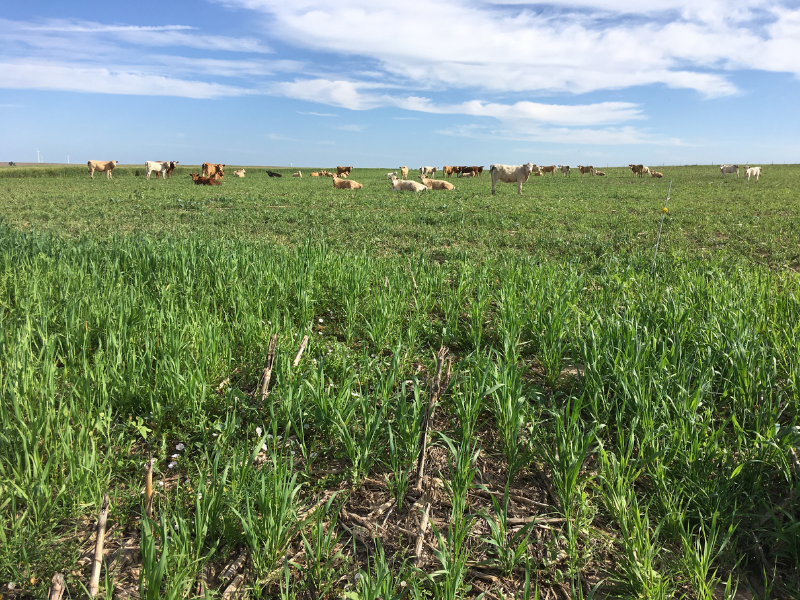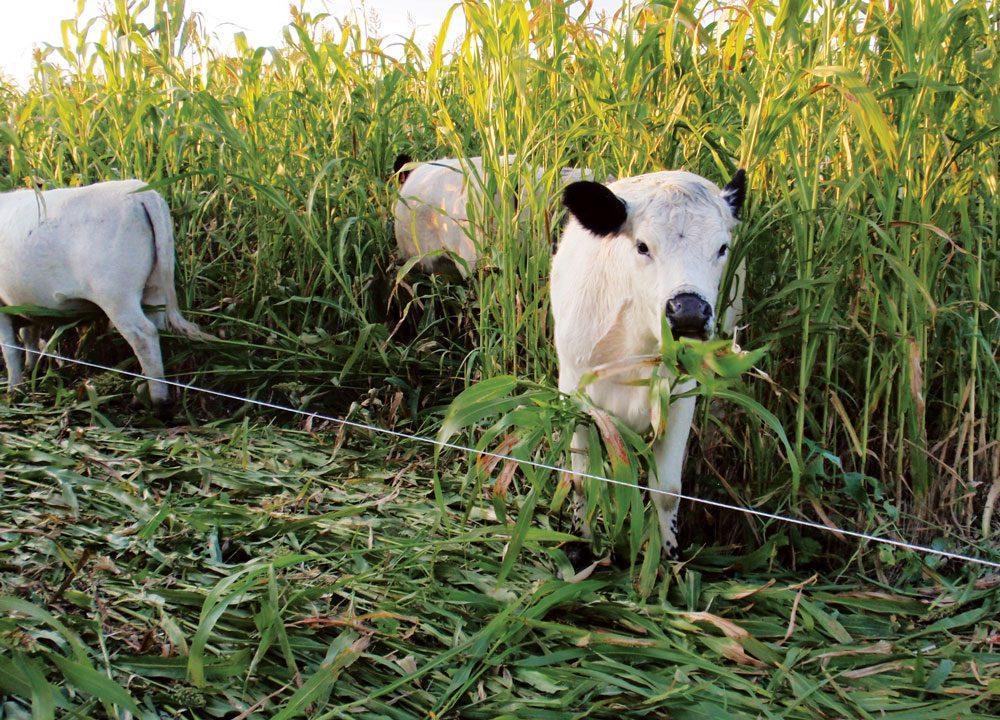Cover crops are typically used by producers in dryland no-till cropping systems to improve soil health, reduce soil compaction, enhance nutrient cycling, improve soil structure, and improve water infiltration.
Producers may be able to realize some income from cover crops by grazing or haying them. But is this a good idea or will it cancel out any benefit the cover crops would otherwise have on soil properties and residue cover?
It is difficult to answer this question in a general way. Each situation can be a little different depending on what species or mixture of different species is being used as the cover crop, the soil texture, the cropping system being used, the timing of the grazing or haying, the stocking rate if it’s being grazed, precipitation and soil moisture conditions, and more.
We recently conducted a two-year study on three producer fields in west central Kansas to study the effect of grazing cover crops on various soil properties. We were also able to compare these soil properties with those of adjacent native perennial pastures.

Figure 1. Cover crop plots being grazed at a farmer’s (Ted Banister) field in Alexander, KS. Photo by Logan Simon, K-State Research and Extension.
Description of the study
It’s important to know specifically what was tested in this study. First of all, there were two locations in 2018-19, and one in 2019-2020:
- 2018-2019. Near Marquette, in northwest McPherson County, on a dryland no-till field in a wheat-wheat-soybean rotation. A winter cover crop mixture of triticale/rapeseed/radish was planted in the fall following the wheat phase and ahead of soybeans. Cover crop grazing by heifers occurred from December 17, 2018 through February 10, 2019 (55 days) at a stocking rate of 5.4 animal unit months (AUM) per acre.
- 2018-2019. Near Hays on a dryland no-till field in a wheat or triticale-sorghum-fallow rotation. A summer cover crop was planted immediately following triticale. Cover crop grazing with lactating cows occurred from August 24 through October 10, 2019 (48 days) at a stocking rate of 5.2 animal unit months (AUM) per acre.
- 2019-2020. Near Marquette on a dryland no-till field in a wheat-sorghum-soybean rotation. A winter cover crop mixture of triticale/rapeseed/radish was planted in the fall following the wheat phase and ahead of sorghum. Cover crop grazing by heifers occurred from January 9 through February 17, 2020 (39 days) at a stocking rate of 4.2 animal unit months (AUM) per acre.
Each site had grazed and ungrazed cover crop plots. Haying was not one of the variables in this study.
Biomass samples were taken before grazing began on the grazed plots, and at the time of termination on both the grazed and ungrazed plots. Soil samples were taken for analysis after the termination of cover crops and before the subsequent soybean or sorghum crop was planted. Soil samples were also taken from adjacent native perennial grass pastures in 2020 at both Hays and Marquette.
Results
Residue cover: In general, grazing reduced the biomass of cover crops, but only by about 29%. The cover crop species used in these tests had significant regrowth after grazing, which compensated for the amount of biomass eaten or trampled by the cattle. The amount of biomass in the grazed plots after grazing was about the same as what is was before grazing, indicating good regrowth. Careful species selection and grazing of cover crops, as done in this study, can leave adequate residue cover to protect the soil and meet soil health goals.
Soil structure: There was no significant difference in soil bulk density, soil aggregate size distribution, or mean weight diameter (MWD) of soil aggregates between grazed and ungrazed cover crop plots. Grazing also had no significant effect on soil organic matter concentrations or soil pH compared to ungrazed cover crop plots.
As a side note, there were many significant differences in soil properties between the cover crop plots and the adjacent pastures. These differences, however, are probably due mostly to the effects of the crop production practices used on the cover crops for several years prior to the start of this study. The results from the pasture samples are included in Table 1 just as a matter of information, but are not relevant to the main objective of the study -- which was to look at the effect of grazing cover crops on plant biomass levels and soil properties.
Table 1. Selected soil physical and chemical properties affected by cover crop management, with a comparison to adjacent perennial pasture soil, 3-year average (aggregates sampled to a 2-inch depth; all other properties sampled to a 6-inch depth)
|
Soil property |
Grazed cover crops |
Ungrazed cover crops |
Pasture |
|
Bulk density (g/cm3) |
1.35 a |
1.31 a |
1.20 b |
|
Large macroaggregate % |
29.2 b |
32.2 b |
68.9 a |
|
Small macroaggregate % |
43.1 a |
43.4 a |
21.8 b |
|
Microaggregates % |
27.7 a |
24.5 a |
9.3 b |
|
Mean weight diameter (in.) of soil aggregates |
0.050 b |
0.051 b |
0.148 a |
|
Soil organic carbon % |
1.55 b |
1.70 b |
2.36 a |
|
Total N % |
0.15 c |
0.17 b |
0.23 a |
|
pH |
5.62 b |
5.76 b |
6.71 a |
|
Means in a row followed by different letters indicate significant differences at a<0.05 | |||
Full details of this study can be found in Kansas Field Research 2021:
https://newprairiepress.org/cgi/viewcontent.cgi?article=8078&context=kaesrr
Other studies
There have been few other studies that have looked at the effect of grazing cover crops on soil properties. One six-year study near Brownell, in Ness County, tested oats-triticale as a cover crop to replace fallow in a no-till wheat-sorghum-fallow rotation. The cover crops were treated as ungrazed, grazed, and hayed. This study also found that bulk density and soil porosity in the cover crop plots were not affected by grazing or haying, and were often not different from fallow.
Soil organic carbon stocks were either greater or similar with cover crops compared to fallow and were dependent upon adequate cover crop residue inputs. Water stable aggregates were consistently larger with standing and grazed cover crops compared to fallow in both years.
The authors of that article conclude: These findings suggest that cover crops may be grown in place of fallow to produce desirable forage of good quality for livestock especially when grazed or hayed early. Further, dual-purpose management strategies may provide benefits to soil health similar to those obtained when cover crops are not grazed or hayed. However, careful management is critical to maintain adequate residue. Grazing cover crops would be more desirable than mechanical forage harvest to maintain soil properties when forage productivity is low.
That study was published in Agronomy Journal: Simon L. M., Obour A. K., Holman J. D., Johnson S. K., Roozeboom K. L. Forage productivity and soil properties in dual-purpose cover crop systems. Agronomy Journal. 2021;113:5569-5583. https://doi.org/10.1002/agj2.20877
Earlier studies by former K-State agronomist Humberto Blanco-Canqui and others in southwest Kansas looked at the effect of haying, but not grazing, of cover crops on soil properties. Results of those studies suggest that harvesting cover crops for forage, being careful to retain adequate residue, may be done without negating potential benefits to soil health. Those agronomists also believed that potential near-surface soil compaction due to cover crop grazing could be eliminated with the alternate wet–dry and freeze–thaw events that occur annually in the Central Great Plains.
Overall conclusions
Based on these results, we conclude that grazing of cover crops can be a viable management option to intensify no-till crop production to improve soil health and maintain or increase overall system profitability. Further research will be needed to determine the long-term effects of cover crop grazing in no-till production systems.





Post a comment
Report Abusive Comment